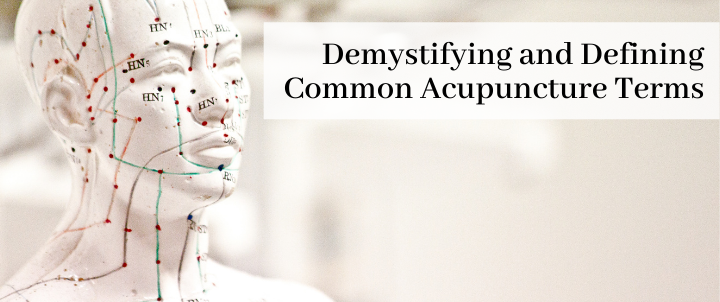
Demystifying and Defining Common Acupuncture Terms
25th April 2022 09:18 AM
Author: The Bridge Centre Team
Struggling to differentiate between your Qi and your Meridians?
Acupuncture is a popular treatment built on ancient principles, and some of its terminology may not be familiar in western culture. In this blog we’re going to be delving into the fascinating world of Acupuncture and explaining what some of the words you might hear actually mean.
Qi
We’ll start with a big one - qi (pronounced “chee”). This is perhaps the toughest on our list to define, but we’re going to give it a go!
In Chinese medicine qi broadly describes the energy, or life force, which flows through the meridians (we’ll come to that one next) in the body. To have balance and harmony within your body, you must have balanced qi. If it becomes unbalanced then functions within the body may be adversely affected, this could be physically, emotionally, or spiritually.
Meridians
The meridians are the channels in the body through which qi flows. It’s blockages along these networks which may interrupt the flow of qi, resulting in imbalance which can cause ill health. Qi flow is restored by treating specific points along the meridians, this may be through acupuncture (needles), heat (moxa) or acupressure. There are 12 Principal Meridians, some of which correspond to specific organs, such as the Heart, Lungs, Kidneys etc, as well as 8 Extraordinary Meridians. Along the meridians are hundreds of Acupuncture Points which Acupuncturists choose from to determine where to place the needles.
Acupuncture Points
Acupuncture Points refer to the specific locations that your acupuncturist may place needles during an Acupuncture treatment. According to The World Health Organisation (WHO) there are at least 361 acupuncture points which are located along each of the major meridians, with additional acupuncture points located along 8 Extraordinary Meridians. All acupuncture points have a name but are generally identified using a combination of letters and numbers with the letter referring to the meridian it’s located on, and a number to show its position along the meridian, for example LI4 refers to 4th point along the Large Intestine meridian. As a side note LI4 is a commonly used Acupuncture Point, and its location is around the fleshy part in-between your thumb and forefinger!
Elements
The Elements refer to the five elements of nature: Fire, Earth, Metal, Water and Wood. The belief in Five Element Acupuncture is that we all embody each of these elements and when they are balanced and working together we flourish, when the elements are not correctly supporting each other, poor health may occur. Each person has a dominant element known as the Causative Factor (CF) and when this is treated is enables all of the Five Elements to work together to achieve optimum health.
Moxa
If you’ve ever had Acupuncture, or visited our centre, you may on occasion have noticed a distinctive smoky smell coming from a treatment room; this is Moxa. Moxa is made from mugwort leaves and is burned on acupuncture points to stimulate them. Please be assured that this does not burn the skin! Moxibustion may also be used by Acupuncturists to help pregnant women with breech babies to try and encourage the baby to move into the preferred position for labour.
That concludes our foray into the world of acupuncture terms, we hope you’ve enjoyed learning more about the wonderful world of Acupuncture with us!
To find out more give the reception team a call on 01332 521 270.
The views expressed in these blogs are those of the blog authors and do not necessarily reflect the views of The Bridge Centre for Natural Health.
Looking For a Particular Treatment?
View the full range of treatments that the Bridge Centre provide.
Recent Posts
- Technical Issues Update 03/04/24
- Technical Issues - March 24
- Z is for ZZZZ
- Y is for You
- Surviving the Autumn / Winter with Five...
- W is for Where is The Bridge Centre
Tags
- Acupuncture,
- Hypnotherapy,
- Osteopathy,
- Massage,
- Pilates,
- Reflexology,
- Fertility,
- Stress,
- wellbeing,
- counselling,
- emotional freedom technique,
- Pregnancy,
- EFT,
- self care,
- Mindfulness,
- Sleep,
- Nutritional Therapy,
- talking therapies,
- Reiki,
- mental health,
- Exercise,
- Relaxation,
- New Year,
- EMMETT Technique,
- Fertility Acupuncture,
- ,
- Grief,
- Bereavement,
- Nutrition,
- Moxibustion,
- Five Elements,
- Sperm,
- Infertility,
- Stop Smoking,
- Meditation,
- Insomnia,
- Anxiety,
- Fibromyalgia,
- Pain,
- carers,
- Deep Tissue Massage,
- back pain,
- Pregnancy Massage,
- Lymphatic Drainage,
- Solution focussed hypnotherapy,
- Hypno-Reiki,
- Cranial Osteopathy,
- detox,
- Digestion,
- Katy Henry,
- Christmas,
- colds,
- immune system,
- Rheumatoid Arthritis,
- Mid life crisis,
- Angelic Reiki,
- Katy Henry Unlimited,
- The Bridge Centre for Natural Health,
- erection,
- Nausea,
- exam stress,
- exams,
- PCOS,
- Runners,
- samantha farmer,
- Winter Health,
- Coughs,
- Caroline Challender,
- K Tape,
- fitness wellbeing,
- sports recovery,
- acute pain,
- chronic pain,
- recovery,
- Sex,
- young carers,
- Sports Massage,
- Hopi Ear Candles,
- Osteopath,
- back care,
- travelling,
- travel,
- Musculoskeletal,
- menopause,
- Diet,
- Hayfever,
- Fitness,
- Pelvic Girdle Pain,
- PGP,
- Resolutions,
- Contact Us,
- smoking cessation,
- Weight management,
- free consults,
- paediatric acupuncture,
- gift vouchers,
- Joint Pain,
- Chinese medicine,
- Qi,
- Cognitive Behavioural Therapy,
- visiting the Centre,
- Depression,


01332 521270